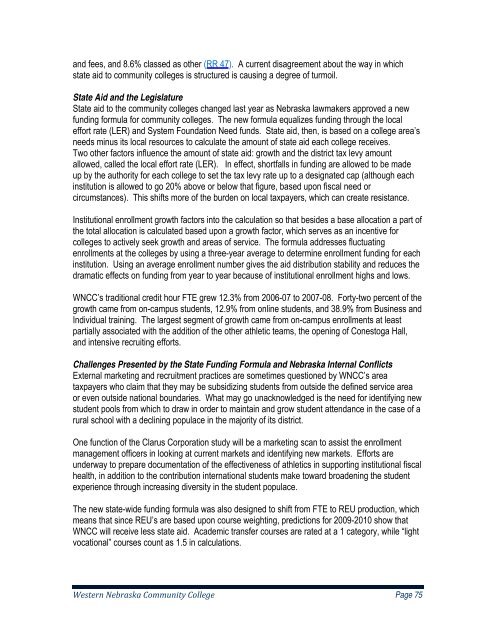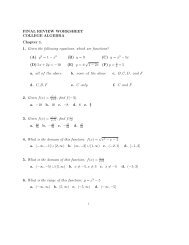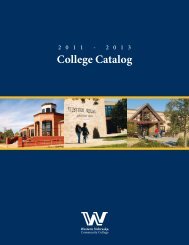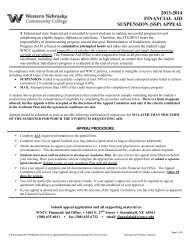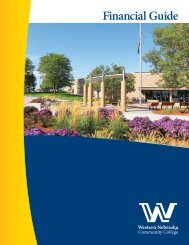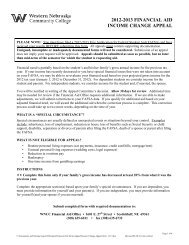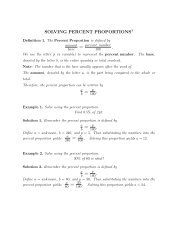WNCC 2010 Self-Study Report - Western Nebraska Community ...
WNCC 2010 Self-Study Report - Western Nebraska Community ...
WNCC 2010 Self-Study Report - Western Nebraska Community ...
You also want an ePaper? Increase the reach of your titles
YUMPU automatically turns print PDFs into web optimized ePapers that Google loves.
and fees, and 8.6% classed as other (RR 47). A current disagreement about the way in which<br />
state aid to community colleges is structured is causing a degree of turmoil.<br />
State Aid and the Legislature<br />
State aid to the community colleges changed last year as <strong>Nebraska</strong> lawmakers approved a new<br />
funding formula for community colleges. The new formula equalizes funding through the local<br />
effort rate (LER) and System Foundation Need funds. State aid, then, is based on a college area’s<br />
needs minus its local resources to calculate the amount of state aid each college receives.<br />
Two other factors influence the amount of state aid: growth and the district tax levy amount<br />
allowed, called the local effort rate (LER). In effect, shortfalls in funding are allowed to be made<br />
up by the authority for each college to set the tax levy rate up to a designated cap (although each<br />
institution is allowed to go 20% above or below that figure, based upon fiscal need or<br />
circumstances). This shifts more of the burden on local taxpayers, which can create resistance.<br />
Institutional enrollment growth factors into the calculation so that besides a base allocation a part of<br />
the total allocation is calculated based upon a growth factor, which serves as an incentive for<br />
colleges to actively seek growth and areas of service. The formula addresses fluctuating<br />
enrollments at the colleges by using a three-year average to determine enrollment funding for each<br />
institution. Using an average enrollment number gives the aid distribution stability and reduces the<br />
dramatic effects on funding from year to year because of institutional enrollment highs and lows.<br />
<strong>WNCC</strong>’s traditional credit hour FTE grew 12.3% from 2006-07 to 2007-08. Forty-two percent of the<br />
growth came from on-campus students, 12.9% from online students, and 38.9% from Business and<br />
Individual training. The largest segment of growth came from on-campus enrollments at least<br />
partially associated with the addition of the other athletic teams, the opening of Conestoga Hall,<br />
and intensive recruiting efforts.<br />
Challenges Presented by the State Funding Formula and <strong>Nebraska</strong> Internal Conflicts<br />
External marketing and recruitment practices are sometimes questioned by <strong>WNCC</strong>’s area<br />
taxpayers who claim that they may be subsidizing students from outside the defined service area<br />
or even outside national boundaries. What may go unacknowledged is the need for identifying new<br />
student pools from which to draw in order to maintain and grow student attendance in the case of a<br />
rural school with a declining populace in the majority of its district.<br />
One function of the Clarus Corporation study will be a marketing scan to assist the enrollment<br />
management officers in looking at current markets and identifying new markets. Efforts are<br />
underway to prepare documentation of the effectiveness of athletics in supporting institutional fiscal<br />
health, in addition to the contribution international students make toward broadening the student<br />
experience through increasing diversity in the student populace.<br />
The new state-wide funding formula was also designed to shift from FTE to REU production, which<br />
means that since REU’s are based upon course weighting, predictions for 2009-<strong>2010</strong> show that<br />
<strong>WNCC</strong> will receive less state aid. Academic transfer courses are rated at a 1 category, while “light<br />
vocational” courses count as 1.5 in calculations.<br />
<strong>Western</strong> <strong>Nebraska</strong> <strong>Community</strong> College Page 75


